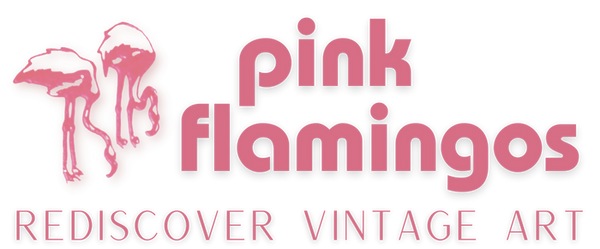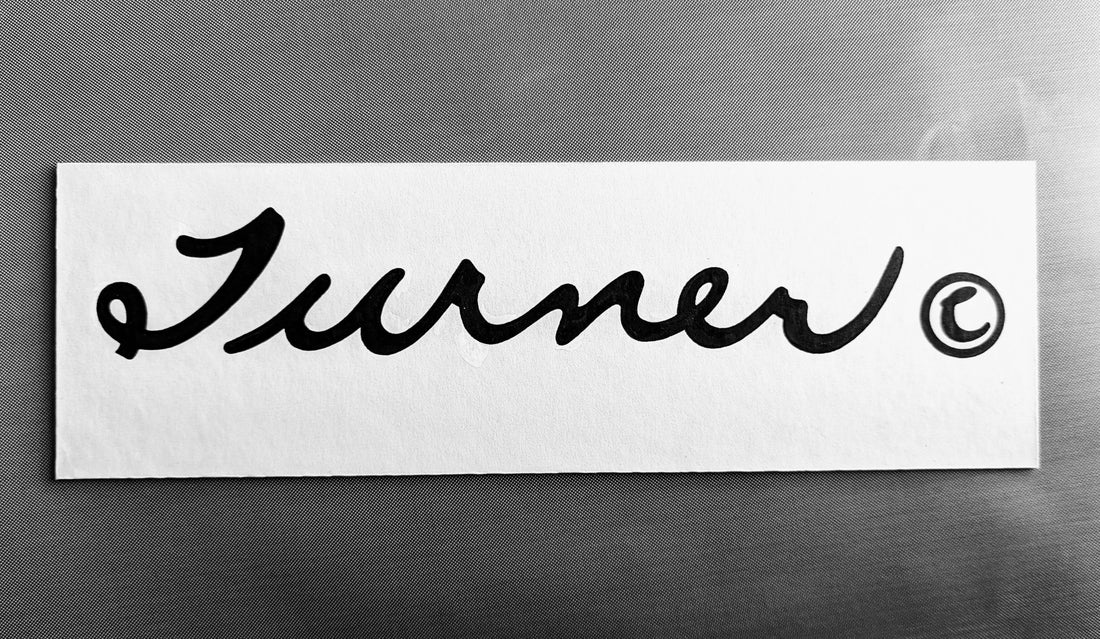Aside from the incredible vintage inventory of artwork that has been passed along to me, I've also received a treasure in dozens of letters, notes, photos, and other research compiled about the artwork by my parents. This blog is one of a two-part series that I'll be publishing this weekend. Both were written circa 1980 by my mom, Victoria Mayes, who spent years researching the famous Turner Flamingo and developed a friendship with several of the original Turner artists and their families. Part I is a transcription of Victoria's hand-written article about Turner, the company, while Part II is the less told other side of the story featuring Toran, the artist.
The Turner Story, written by Victoria Mayes, circa 1980

The author's original handwritten draft.
“Oh yes, I remember that picture hanging on my grandma’s wall…”
But it seems the pictures of mirrored florals and tropical birds, popular and prolific in the 1940’s, are becoming extinct. Suffering, age, and general abuse over the years, they were “handed down” and eventually thrown out instead of repaired, then so common to the point of becoming boring.
Suffering general abuse or neglect over the years, “that picture” was handed down and eventually thrown out instead of repaired, since it was then so common and everybody had one.
So now it follows that the pictures of mirrored florals and tropical birds, so popular and prolific in the 1940’s, are becoming an endangered species.
Air brush technique, light color lithography, hand painted borders and mirrored frames created an art form that at the time was available for purchase in all the main department stores and was priced reasonably. It was even a common practice for furniture stores to use the pictures, especially the type with the mirror overlay, as a give-away to help promote room full or house full of furniture purchase.

Original 1943 advertisement on Turner's Beautytone prints sold by The May Company.
Who was the artist? A signature with the indication of a copyright is readily seen on the pictures.
The Flamingo, Cockatoo, Egret and Swan pictures are signed Turner© as are numerous florals, colonials, and landscapes…
Turner signature on the famous Turner Flamingo print.
Turner copyright on the Pink Cockatoo print.
“Mrs. Turner was a lady artist whose husband manufactured and distributed her art…she also was an illustrator for the National Audubon Society. She sold the factory after he passed away in the early 50’s.”
Where was the factory located? As this question was answered it became apparent that there never was a lady artist named Turner, but there was a Turner Manufacturing Company. The company first came into existence circa the 1930’s. As was common practice by large picture frame manufacturing companies in the 1930’s and 1940’s, Turner Manufacturing Company hired numerous artists to create original artwork to help sell the Turner frames. Since the cost of production was paid solely by the company, Turner Manufacturing signed and copyrighted each picture while the artist was paid for the number he or she was able to produce.

Turner Manufacturing Company: General Office Entrance, Chicago, ~1980

Turner Manufacturing Company: World's Largest Producer of Wall Accessories, Chicago, ~1980
One of the first processes was the air brush technique utilizing a compressor. Originals were made and stencils cut so duplicates could be sprayed in large quantities. During the Depression, struggling artists were paid $0.35 - $1.00 per picture produced.
Later on, to increase production, pictures were printed in light sepia, were sprayed then hand painted touches were added to make the look more original and handmade. This still wasn’t fast enough, so pictures were then printed in color with handmade finishing touches added. Each picture had a label pasted on it: “Hand decorated by American Artists.” These were hard times for struggling young artists during the Depression and war years.
Finally, the demand was great for certain pictures, that light color lithography became the method of production. Turner Mfg. claims a “platinum record” for the most prints ever produced up to the 1950’s on their one most popular subject of flamingos.



